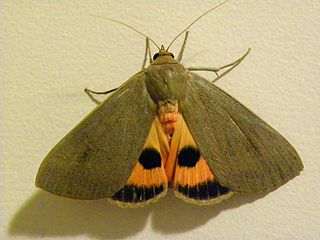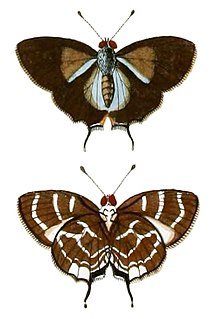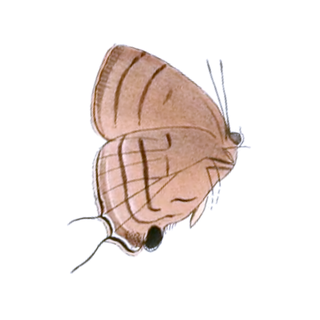
Oecophoridae is a family of small moths in the superfamily Gelechioidea. The phylogeny and systematics of gelechoid moths are still not fully resolved, and the circumscription of the Oecophoridae is strongly affected by this.

The Elachistidae are a family of small moths in the superfamily Gelechioidea. Some authors lump about 3,300 species in eight subfamilies here, but this arrangement almost certainly results in a massively paraphyletic and completely unnatural assemblage, united merely by symplesiomorphies retained from the first gelechioid moths.

The Nymphalinae are a subfamily of brush-footed butterflies. Sometimes, the subfamilies Limenitidinae, and Biblidinae are included here as subordinate tribe(s), while the tribe Melitaeini is occasionally regarded as a distinct subfamily.

The Satyrinae, the satyrines or satyrids, commonly known as the browns, are a subfamily of the Nymphalidae. They were formerly considered a distinct family, Satyridae. This group contains nearly half of the known diversity of brush-footed butterflies. The true number of the Satyrinae species is estimated to exceed 2,400.

Melitaea is a genus of brush-footed butterflies. They are here placed in the tribe Melitaeini of subfamily Nymphalinae; some authors elevate this tribe to subfamily rank.

The Pyralini are a tribe of snout moths described by Pierre André Latreille in 1809. They belong to the subfamily Pyralinae, which contains the "typical" snout moths of the Old World and some other regions. The genus list presented here is provisional.

Atlides is a genus of gossamer-winged butterflies. Among these, it belongs belong to the tribe Eumaeini of the subfamily Theclinae. These small butterflies are widespread in the Americas, occurring almost anywhere between the southern United States and Argentina.

Balintus is a gossamer-winged butterfly genus of the tribe Eumaeini in the subfamily Theclinae. Its only known species, Balintus tityrus, is found in the Neotropical realm, where it is endemic to Colombia.

Lamasina is a genus of gossamer-winged butterflies ; the validity of its name is subject to dispute. Among its family, these sexually dimorphic Lepidoptera belong to the tribe Eumaeini of the subfamily Theclinae. Lamasina species are found mainly in northern South America, approximately to the Guyanas. L. draudti is also found in Central America south of the Yucatán Peninsula. In the Andes, the genus extends somewhat further south; L. rhaptissima almost reaches Bolivia.

Megathecla is a gossamer-winged butterfly genus of tribe Eumaeini in the subfamily Theclinae. These butterflies are found in the Neotropical realm. The distinctness of this genus was only recognized after the year 2000, even though the type species M. gigantea has been scientifically known since the late 19th century.

Salazaria is a gossamer-winged butterfly genus of tribe Eumaeini in the subfamily Theclinae. As far as is known, these butterflies occur in the northern Andean region around Ecuador.

Thereus is a genus of gossamer-winged butterflies. Among these, it belongs belong to the tribe Eumaeini of the subfamily Theclinae. These small butterflies occur essentially all over the Neotropics.

Theritas is a genus of gossamer-winged butterflies found in the Neotropics. Among the tribe Eumaeini of its subfamily Theclinae, it is usually placed in the group around the genus Atlides. In particular, it seems most closely related to Arcas.
Stenoptinea is a genus of the fungus moth family, Tineidae. Therein, it belongs to the subfamily Meessiinae. It was originally established as a subgenus of Homosetia, but later separated to become a genus in its own right.

Nemaxera is a genus of the fungus moth family, Tineidae. Therein, it belongs to the subfamily Nemapogoninae. The genus is considered monotypic, with the single species Nemaxera betulinella placed here.

Crassa is a genus of the concealer moth family (Oecophoridae). Among these, it belongs to subfamily Oecophorinae. The genus name Tichonia, established by J. Hübner in 1825, was frequently misapplied to these moths by earlier authors. But as the type species of Hübner's genus is the greenweed flat-body moth – originally described as Tinea atomella, but nowadays called Agonopterix atomella –, Tichonia is actually a junior synonym of Agonopterix. That genus does belong to the same superfamily as Crassa, but is placed in the concealer moth subfamily Depressariinae which is sometimes treated as distinct family.
Schiffermuelleria is a genus of gelechioid moths. It is placed in the subfamily Oecophorinae of family Oecophoridae. The genus is treated as monotypic, with the single species Schiffermuelleria schaefferella placed here. As such, its distinctness from the closely related genus Borkhausenia – where S. schaefferella was often placed in the past – is open to debate.

Abananote is a genus of butterflies from north-western South America of the subfamily Heliconiinae in the family Nymphalidae. For taxonomic problems regarding this group, see Acraea.

Hyantis is a monotypic nymphalid butterfly genus. Its sole species is Hyantis hodeva, which is found in New Guinea. It is uncertain which tribe this butterfly should be placed within.

















